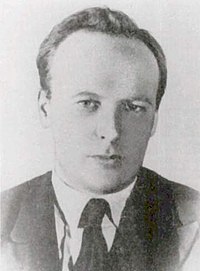Evgeny Zavoisky
| Yevgeny Zavoisky | |
|---|---|
 |
|
| Born | September 28 [O.S. September 15] 1907 Mogilyov-Podolsk |
| Died | 9 October 1976 (aged 69) Moscow |
| Alma mater | Kazan University |
| Known for | Discovery of electron paramagnetic resonance (1944) |
| Awards | Stalin Prize (1949), Lenin Prize (1957), International EPR Society Prize (1977, posthumously) |
| Scientific career | |
| Fields | Spectroscopy |
| Institutions | Kazan University, Arzamas-16, Institute of Atomic Energy |
| Signature | |
Yevgeny Konstantinovich Zavoisky (Russian: Евгений Константинович Завойский; September 28, 1907 – October 9, 1976) was a Soviet physicist known for discovery of electron paramagnetic resonance in 1944. He likely observed nuclear magnetic resonance in 1941, well before Felix Bloch and Edward Mills Purcell, but dismissed the results as not reproducible. Zavoisky is also credited with design of luminescence camera for detection of nuclear processes in 1952 and discovery of magneto-acoustic resonance in plasma in 1958.
Zavoisky was born in 1907 in Mogilyov-Podolsk, a town in the south of Russian Empire (now in Vinnytsia oblast, Ukraine). His father Konstantin Ivanovich was a military doctor and mother Elizaveta Nikolaevna was trained as a teacher. In 1910, Zavoisky family moved to Kazan – a major Russian university city – for the sake of better education and well-being of their five children. There, Konstantin Ivanovich obtained a respectable job and a large apartment, which he equipped with equipment and books for home experiments with his children. Yevgeny, in particular, was keen to electromagnetism.
The October revolution of 1917 brought difficult times. Konstantin Ivanovich died in 1919 from exhaustion, and the family moved to a small rural town to survive the hunger period. They returned to Kazan in 1925. In 1926, Yevgeny entered the faculty of physics at Kazan University. By that time, he was already an experienced amateur engineer who had assembled his own radio receivers and had numerous ideas of new inventions and measurements. Zavoisky established himself as a talented student and researcher. He was sent to Saint Petersburg to continue his studies and after returning to Kazan had worked in the laboratory of oscillations at Kazan University. After defending his PhD in 1933, he became the laboratory head. His research directions included generation of ultrashort waves; study of their physical and chemical effects on matter, including the effect on seed germination; and investigation of superregenerative effect. The seed germination topic was a reflection of that difficult period when scientists were required to try helping the Russian economy, which was recovering from the years of wars.
...
Wikipedia
